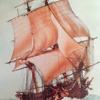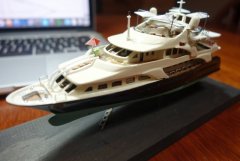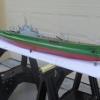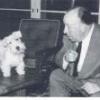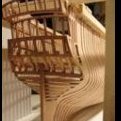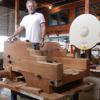Supplies of the Ship Modeler's Handbook are running out. Get your copy NOW before they are gone! Click on photo to order.
×
-
Posts
1,582 -
Joined
-
Last visited
Reputation Activity
-

-
 albert got a reaction from Canute in HM Cutter Cheerful 1806 by Chuck - FINISHED - 1:48 scale - kit prototype
albert got a reaction from Canute in HM Cutter Cheerful 1806 by Chuck - FINISHED - 1:48 scale - kit prototype
Very beautiful work.
-

-
 albert got a reaction from mtaylor in HM Cutter Cheerful 1806 by Chuck - FINISHED - 1:48 scale - kit prototype
albert got a reaction from mtaylor in HM Cutter Cheerful 1806 by Chuck - FINISHED - 1:48 scale - kit prototype
Very beautiful work.
-
 albert reacted to ggrieco in Heroine 1838 by ggrieco - FINISHED - Scale 1:24 - Western River Steamboat as she appeared before hitting a snag in the Red River
albert reacted to ggrieco in Heroine 1838 by ggrieco - FINISHED - Scale 1:24 - Western River Steamboat as she appeared before hitting a snag in the Red River
Well, I started the week off with a major mistake. I had hoped to finish the engine this week but, while adding the spreaders to the paddlewheel flanges, I realized that I had them reversed on the port side. The inboard flange was on the outside and outboard on the inside. It was pretty frustrating heating and desoldering the blackened parts with the spokes in place. I always lightly peen the end of the bolts so that the nuts won't back off over time. Makes for a secure hold but impossible to ever disassemble without cutting the heads off. After finally resoldering the flanges and burning some of the spokes, I noticed that the notches on the after edges of the ends of the spokes were now on the wrong side. I spent a good part of the week making new spokes and I'll have to wait for a new batch of 00-90 screws to arrive.
After several attempts at different methods to make the chimney segments, I finally came up with a method that works well. The tubes taper upward by less than a degree which allows each one to fit tightly inside the one above. Using AutoCAD, I calculated the the upper and lower radii and the angled sides of the plates needed for the segment. I added 1/8 inch on one side for overlap. Printed on label paper and applied to the brass, I cut out the .01 thick plates. As long as the rigth edge lined up with the inner line on the left, the shape came out accurately. The individual segments mated perfectly giving me a nice straight tube. I was able to make four segments in less than thirty minutes. Unfortunately, I ran out of brass before I could make a complete tube.
Kevin's drawing of Heroine's chimney.
Paper patterns for the chimney segments. The edges look straight but, the sides taper less than 1 degree and the top and bottom have a extremely large radius (152.36 inches for the bottom 149.86 inches for the top)
-
 albert got a reaction from EJ_L in La Créole 1827 by archjofo - Scale 1/48 - French corvette
albert got a reaction from EJ_L in La Créole 1827 by archjofo - Scale 1/48 - French corvette
Wonderful model, very very nice, fantastic work.
-
 albert reacted to Chuck in HM Cutter Cheerful 1806 by Chuck - FINISHED - 1:48 scale - kit prototype
albert reacted to Chuck in HM Cutter Cheerful 1806 by Chuck - FINISHED - 1:48 scale - kit prototype
The bobstay was rigged today. I used a length of .025 dark brown rope that was served its entire length. A 3/16" single block was seized to one end while the other end was placed through the hole in the stem. That end was seized to itself as shown in the photos.
The bobstay tackle was set up with .012 light brown rope. The running end of the tackle being brought inboard and belayed to the pin rail at the bow. I did not glue the belaying point at all. It is simply fixed on the belaying pin by using a simple twist of the loop around the pin's bottom. I will leave the running end a bit long for now as with all of the other lines. This line may go slack depending on the tensions from other lines etc. So not using any glue until much later (if at all) will give me an easy opportunity to loosen it at the belaying in and re-tension to suit.
This will be extremely important when I turn in the deadeyes for the shrouds and set up the backstays. Once the backstays are rigged it has a tendency to make the aft shrouds go a bit slack....being able to re-tension is a huge factor so no lines will be made permanent until much later if at all. The rigging is not pulled to tight at this point. Just enough tension so it doesnt go slack. I see so many models with teh rigging so tight it causes big issues.
I have restored many models that were 100+ years old and the lines were never glued permanently. This made fixing them and re-tensioning so easy that I have decided to give it a try on my models. Just pull out the belaying pin and the line is free to be re-tensioned.
-

-
 albert reacted to tadheus in La Salamandre by tadheus - 1:24
albert reacted to tadheus in La Salamandre by tadheus - 1:24
Continuation.
The beginning of the relation is available at this address:
http://5500.forumact...ndre-1-24#66516
Regards, Pawel
-
 albert got a reaction from Omega1234 in La Mutine and La Topaze by Gregor – 1:64 scale - French Schooners - La Jacinthe Type
albert got a reaction from Omega1234 in La Mutine and La Topaze by Gregor – 1:64 scale - French Schooners - La Jacinthe Type
Very nice work.
-
 albert got a reaction from mtaylor in La Créole 1827 by archjofo - Scale 1/48 - French corvette
albert got a reaction from mtaylor in La Créole 1827 by archjofo - Scale 1/48 - French corvette
Wonderful model, very very nice, fantastic work.
-
 albert got a reaction from mtaylor in La Mutine and La Topaze by Gregor – 1:64 scale - French Schooners - La Jacinthe Type
albert got a reaction from mtaylor in La Mutine and La Topaze by Gregor – 1:64 scale - French Schooners - La Jacinthe Type
Very nice work.
-
 albert reacted to archjofo in La Créole 1827 by archjofo - Scale 1/48 - French corvette
albert reacted to archjofo in La Créole 1827 by archjofo - Scale 1/48 - French corvette
Hello,
about your nice hints and positive comments.
I am extremely happy.
Here we go on with the building report:
Further details have been installed, such as pin rails.
-
 albert reacted to Gregor in La Mutine and La Topaze by Gregor – 1:64 scale - French Schooners - La Jacinthe Type
albert reacted to Gregor in La Mutine and La Topaze by Gregor – 1:64 scale - French Schooners - La Jacinthe Type
Thanks, Tony, you are kind. The important difference is that on Mutine's hull the tiles overlap (historically correct), but on the model this has a three-dimensional effect. On Topaze's hull, I put the tiles precisely along each other, so the copper skin is flatter and smoother.
-
 albert got a reaction from Canute in Granado by rafine - FINISHED - Caldercraft - 1:64
albert got a reaction from Canute in Granado by rafine - FINISHED - Caldercraft - 1:64
Hi Bob, very great beautiful work.
-

-
 albert reacted to Mirabell61 in SS Kaiser Wilhelm der Grosse 1897 by Mirabell61 - FINISHED - scale 1:144 - POF - first German four stacker of the Norddeutscher Lloyd line
albert reacted to Mirabell61 in SS Kaiser Wilhelm der Grosse 1897 by Mirabell61 - FINISHED - scale 1:144 - POF - first German four stacker of the Norddeutscher Lloyd line
update...
been building the two bases for the machine-room skylights, above the engine room shaft, that bear each six ventilation skylight housings with again each 6 panel flaps. So that will be in total 36 opening flaps with each 4 round light openings ( 36 flaps x 4 = 144 "portholes")
This surely will take some time from now on.
The flaps will be made from 8 mm wide brass strip, and the "portholes" like I usualy do it...
Nils
sample of this detail borrowed of a card build model from the web.....
trying for the right hole pattern (4 holes) per panel.
The upper 4 ones look OK.
The hole-frames are made from shortend hollow rivets and soldered on to the panel
The green tape is for preventing the bottom ventshaft rings to slip off and get lost
-
 albert got a reaction from Martin W in Granado by rafine - FINISHED - Caldercraft - 1:64
albert got a reaction from Martin W in Granado by rafine - FINISHED - Caldercraft - 1:64
Hi Bob, very great beautiful work.
-
 albert reacted to Mahuna in Dunbrody by Mahuna - FINISHED - 1:48 - Cross-Section - Irish Famine Ship
albert reacted to Mahuna in Dunbrody by Mahuna - FINISHED - 1:48 - Cross-Section - Irish Famine Ship
Part 49 – Deadeyes and Chainplates Version 2
I wasn’t really happy with the results of my first try at making the deadeyes and chainplates for Dunbrody. After lots of thought (much of it in the middle of the night when I should have been asleep), I decided that a couple of jigs would help with the precision.
Twisting the chainplate to form the hinge, as in the prior attempt, would most likely result in a number of variances from one deadeye to another. When viewing a single deadeye the result might be acceptable, but when 6 or 8 deadeyes are lined up next to each other the differences would surely stand out.
The original attempt started with soldering a piece of 1/32 round bar to the chainplate, which is 3/32 x 1/64. This gave a good impression of a hinge, but centering and shaping the hinge and the shoulders of the chainplate was problematic, and that’s when I decided to twist the chainplate stock to form the hinge. The new process starts with the round bar, and I thought some viewers may be interested in seeing how resistance soldering works.
The first photo shows the soldering setup. The jig consists of a piece of corian milled so that the groove for the chainplate is the same depth as the thickness of the stock, and the groove for the round stock is the correct depth for the chainplate to lie at the center of the round stock.
The large black clamp simply holds the jig on the table. The yellow plastic clamp is holding the chainplate to the jig, and the orange plastic clamp is holding the round bar stock to the jig. The alligator clip attached to the chainplate is the negative electrode attached to the resistance soldering power unit.
After the setup is secured, flux is applied as in any other soldering process.
I’m using Stay-Clean flux – this normally comes with Sta-Brite solder. I use a silver-bearing solder from Radio Shack, mainly because it comes as a very thin wire, so it’s easy to clip off a very small piece and avoid wasting solder and making cleanup harder. In the following photo you may be able to see the very small piece of solder pointed to by the tweezers.
Heating the solder is accomplished by holding the positive electrode to the workpiece – normally at the thickest part – and depressing the footswitch. With pieces this small the soldering takes only a few seconds.
The piece cools down almost immediately, so it’s not necessary to wait or to immerse the piece in a cooling bath. The next step is to clip off the excess round bar.
Shaping a piece this small by eye so that it is symmetrical and repeatable is very difficult. A shaping template was made on the mill so that the piece could be tested as it was being shaped (shaping was done with a small parallel Barrette file – number 4).
The square hole on the left is for the initial shaping to get the size of the hinge consistent and centered. The hole on the right was shaped using a rounded end mill and indicates the shoulders of the chainplate. The following photo shows the first step in shaping the hinge.
After the shoulders were rounded the profile of the hinge is finished.
The strop is a piece of 1/32 x 1/64 flat bar stock. The strop is annealed (heated to a red color and then quenched) to soften the stock and make it easier to bend. During my first attempts I bent the strop around the deadeye itself. This resulted in the strop being completely around the deadeye with little or no room for the hinge arrangement. I decided to make a bending jig that would ensure a sufficient opening in the strop. This jig consists of a piece of round brass stock shaped to the proper diameter on the lathe and with a groove cut in for the strop. It also has a piece of flat stock of the same thickness as the hinge soldered into a slot that was cut into the jig.
The strop is bent around the jig and tightened by squeezing the ends to the protruding piece.
The strop is then added to the deadeye and the assembly is placed in the jig for forming the assembly (same jig as previously used).
The deadeye being used in the picture has been used in several previous attempts, so is discolored. This won’t be an issue when the ‘production’ deadeyes and chainplates are being assembled.
The ends of the strop are then clipped down to the finished length and the protruding ends are rounded.
The chainplate is then soldered to the deadeye hinge, using the setup shown in the following photo.
I’m much happier with the results of this new process. Making a single deadeye/chainplate combination takes less than an hour with this new process, and is very repeatable.
The shaping definitely requires the use of an Optivisor, since these deadeyes are fairly small.
So now I guess I’d better start making the ‘production’ deadeyes before I forget how!
Thanks, everyone!
-

-

-

-

-

-
 albert reacted to tadheus in La Salamandre by tadheus - 1:24
albert reacted to tadheus in La Salamandre by tadheus - 1:24
Continuation.
The beginning of the relation is available at this address:
http://5500.forumact...ndre-1-24#66516
Regards, Pawel


